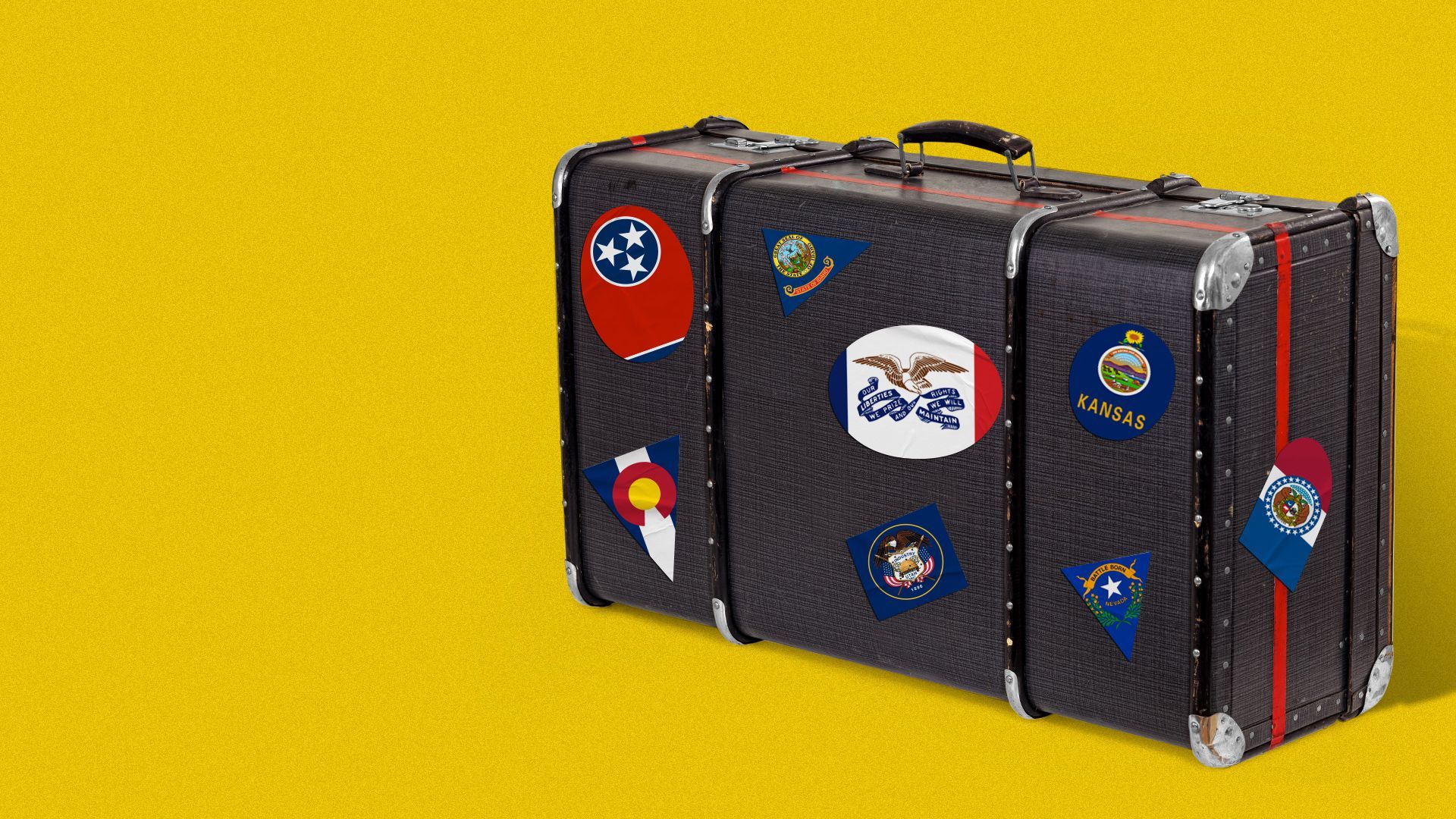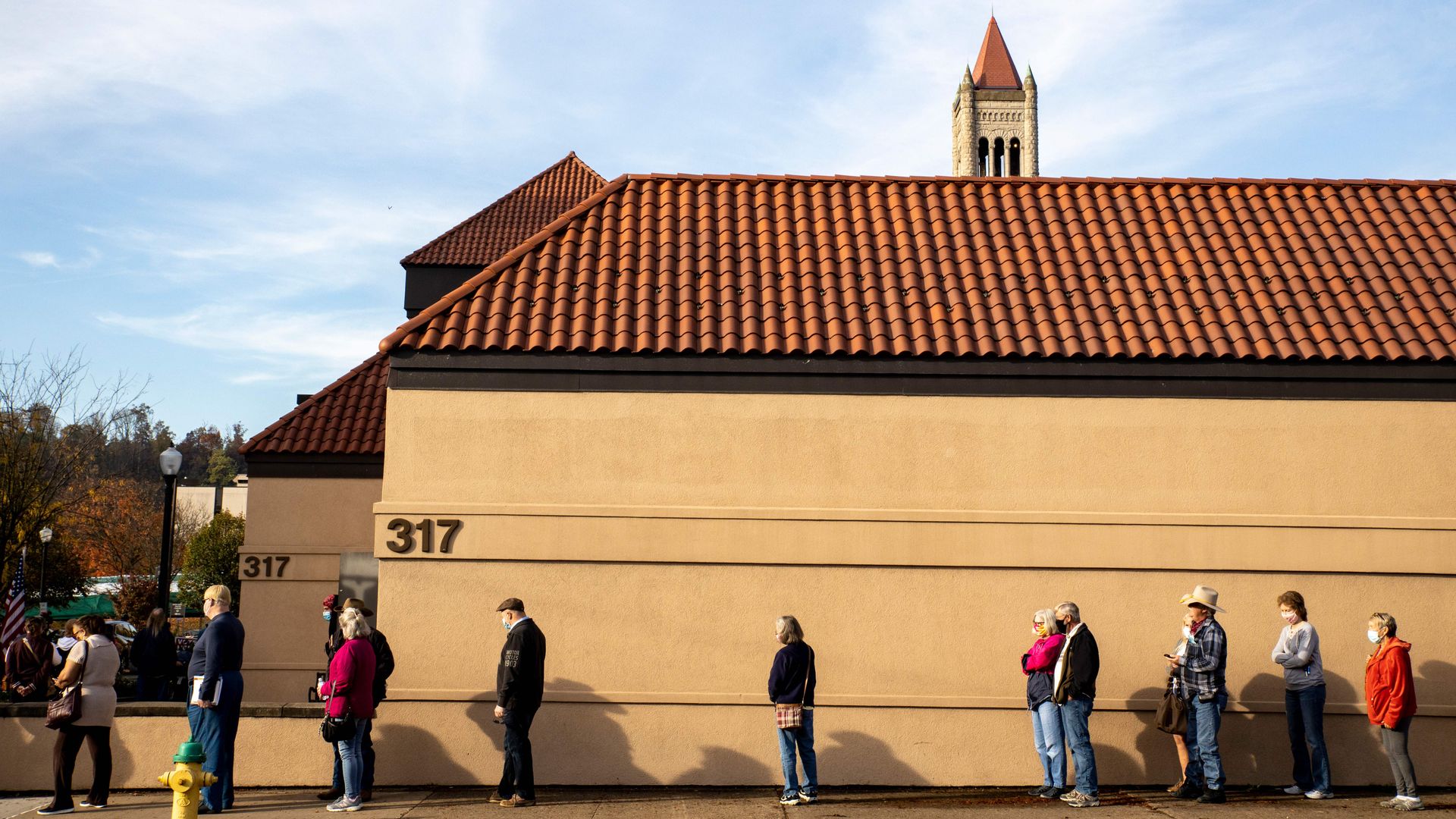| | | | | | | Presented By Google | | | | Axios @Work | | By Erica Pandey ·Oct 27, 2020 | | Welcome back to @Work. We're one week out from the election, and I'd love to hear about how politics has (or hasn't) made its way into your workplace. - Are political discussions coming up on Zoom calls? Has your firm directed employees not to talk about politics, or is it encouraging discourse? How do you think the election and its aftermath will affect your office's culture?
- As usual, get in touch with me at erica@axios.com or on Twitter @erica_pandey.
I've got 1,716 words for you today — a 6½-minute read. To start... | | | | | | 1 big thing: Americans are moving again |  | | | Illustration: Aïda Amer/Axios | | | | For decades, the share of Americans moving to new cities has been falling. The pandemic-induced rise of telework is turning that trend around. Why it matters: This dispersion of people from big metros to smaller ones and from the coasts to the middle of the country could be a boon for dozens of left-behind cities across the U.S. By the numbers: 22% of American adults either moved or know someone who moved during the pandemic, according to a Pew Research Center survey. - Flashback: Fewer than 10% of Americans moved to new places in 2019, the lowest rate since the Census Bureau began tracking domestic relocations in 1947.
The two biggest exoduses are out of New York City and San Francisco, per data from moving companies cited by Bloomberg's CityLab. - HireAHelper said requests for help moving out of a New York or San Francisco home were 80% higher than requests to move in over the summer.
- United Van Lines saw moves out of New York and San Francisco jump 45% and 23%, respectively, during the summer months.
- And while many of the people moving out of these cities are going to other superstar metros — the top destination from San Francisco is Seattle, and the top destination from New York is Los Angeles — many other are relocating to smaller, up-and-coming cities, like Tampa Bay, Raleigh, Houston and Denver.
The impact: Before the pandemic, the top 15 most expensive cities in the country had just 19% of the population but the vast majority of business activity, writes Adam Ozimek, chief economist at Upwork, which connects freelancers to employers. Now, with remote work, 49% of business spend on Upwork's platform is going from those cities to lower-cost places, he notes. - And while companies like Facebook and Microsoft have said they'll adjust workers' salaries according to the local cost of living if they move to less-expensive places, the relocation could still be worth it, Ozimek says.
- The price-to-income ratio — which is the ratio of the median price of a home to the median annual household income in a given area — in the top 15 most expensive cities is double (or more) than in the rest of U.S. cities.
But, but, but: The migration numbers have been inflated by the massive spike in young adults, aged 18–29, moving back home during the pandemic. - "I think this is temporary," says University of Toronto urbanist Richard Florida. While nearly 30 million young people have moved back in with their parents since March, most of them will return to the big cities they left when the pandemic is behind us.
The bottom line: It's too early to tell whether American migration has made a true comeback, but the pandemic has — at least in part — shaken up a decades-long period of stagnation in the country. |     | | | | | | Bonus: The latest tech company to lean into telework | | Reddit announced its remote work policy today. The company will let any employee work from home as much as they want if their job allows. - Reddit sets itself apart from other tech companies by promising not to lower employees' compensation according to local cost of living if they move away from the office.
- That means you could live in Columbus, Ohio, and make Bay Area money.
Go deeper: Breaking down Microsoft's telework move |     | | | | | | 2. The pandemic-era career switch |  | | | Illustration: Aïda Amer/Axios | | | | Many Americans who have been out of work for months and hold jobs in struggling industries like travel and hospitality are thinking about switching careers entirely. The big picture: It's not so easy. Jumping into new roles and new fields requires training, which can be too costly or difficult to come by. And even after training, starting all over again usually means a huge pay cut, experts say. Let's zoom in on restaurants. In February, food service workers were 3.1 times more likely to click on food service job postings than any other postings, according to Indeed data provided to Axios. - In April, they were just 1.9 times as likely to do so. Interest rebounded to 2.7 times by September, as restaurants slowly started to reopen, but it still remains well below pre-pandemic levels.
- "With colder weather starting to settle in, the restaurant industry faces tremendous challenges ahead," says AnnElizabeth Konkel, an economist at Indeed. "Depending on how the winter goes, food service worker interest in their sector may struggle to fully recover."
But getting jobs outside of your industry often requires reskilling and retraining, and while there are some success stories, many workers don't want to or can't afford to go back to school. - "People want jobs. They don't want training," says Anthony Carnevale, director of the Georgetown University Center on Education and the Workforce.
- The prospect of starting over seems daunting to workers, especially if they are older than 40, he says. And even when people do successfully switch careers, they start with a 40% pay cut, on average.
"Some will be able to make the jump to a new a career right away," says Jane Oates, president of WorkingNation, a nonprofit that raises awareness about the challenges facing U.S. workers, and a former Labor Department official. - Think of a banker who loses their job when a branch closes and finds new work doing back-office finances at a company.
- For a bartender, such a switch might seem tougher. But that person can leverage their people skills for jobs in customer service in new industries.
- "Anybody who has earned a paycheck has skills," says Oates.
Go deeper: USA Today dives into career-switching with the story of a bartender-turned-coder. |     | | | | | | A message from Google | | How to be ready for what comes next | | |  | | | | What makes a business resilient? New research from Google reveals that merging automation with human insight can help businesses meet the challenge to be ready for what comes next in 2021. Explore the latest research on Think With Google. | | | | | | 3. The dented labor market |  Reproduced from Pew Research Center; Chart: Axios Visuals The child care crisis is shrinking the labor market. - New data from Pew Research Center shows that parents are being hit especially hard by the coronavirus pandemic, and as far as job losses go, mothers and fathers are faring equally poorly.
- And the decline of women's growth as a share of the labor force reverses what had been a broad-based economic tailwind for the U.S, Axios' Dion Rabouin and I report.
What's happening: "The share of mothers and fathers who were employed and at work plunged with the onset of the coronavirus outbreak and had recovered only partially through September 2020," writes Rakesh Kochhar, senior researcher at Pew. - "The gender gap in September (22 percentage points) is slightly greater than in February (20 points), but a similar gap was also present in September 2019."
- More parents also are dropping out of the labor force altogether, Pew's data show. That means they're not looking for work.
- The share of women employed and at work is the lowest it has been in 35 years. The share of men at work is the lowest it has ever been.
Why it matters: "If you want to maximize economic growth, you want all working-age adults to be engaged with the labor market at their maximum capacity," Misty Heggeness, a visiting scholar at the Minneapolis Fed, tells Axios. "We're cutting ourselves short as a society." The bottom line: "There is no new normal to this. It just keeps getting worse every day," says Alicia Modestino, an economics professor at Northeastern University and a former senior economist at the Boston Fed. - "When you look down the barrel of hybrid or remote learning for an entire year, as a working parent you just want to cry."
|     | | | | | | 4. Stat of the day: Who has workers' trust? | | 82% of American workers approve of their company leadership's response to the coronavirus pandemic, according to a new SurveyMonkey poll. - Compare that with the 57% who approve of their governor's state-level response and the 46% that approve of President Trump's federal response.
- The approval of CEO responses is fairly equal across party lines, with 87% of Republicans and 83% of Democrats saying they trust their employers to navigate the crisis.
Why it matters: This trust gap is yet another sign that CEOs are filling the leadership void left by politicians at all levels across America. A note on methodology: These data come from a set of SurveyMonkey online polls conducted Oct. 12–18 among a national sample of 51,417 employed adults in the U.S. The modeled error estimate for this survey is ±1.0 percentage points. Data have been weighted for age, race, sex, education and geography using the Census Bureau's American Community Survey to reflect the demographic composition of the United States age 18 and over. |     | | | | | | 5. Worthy of your time |  Data: Cognizant; Chart: Andrew Witherspoon/Axios Pandemic postpones jobs of the future (Axios) - Many of the digital jobs of the future have suffered during the later stages of the pandemic, while in-person health care jobs are on the rise. Automation and digitization will profoundly change the U.S. labor market, but that future has been delayed as COVID-19 forces companies to shift into survival mode.
New York could turn into a hub for labs (New York Times) - New York City's office real estate market has been battered by the coronavirus pandemic, and life sciences companies are finding a silver lining in that. A ton of available space and cheaper rents mean that firms can gobble up space to build big laboratories — facilities that the city has historically lacked.
The rise of the kid cubicle (Marker by Medium) - There's been a pandemic-induced surge in office supplies for children as parents try to build classrooms at home. Sales of desks for kids are up 129%, Wayfair tells Marker's Jennifer Alsever.
Parents are zoom-bombing remote school (Wall Street Journal) - Millions of parents are working remotely as their kids are learning remotely — and many can't resist the urge to pop into those Zoom classrooms and get involved. Teachers are dealing with parents who interrupt class to ask questions, text in feedback during the lesson or even do kids' work for them.
|     | | | | | | 6. 1 🇺🇸 thing: Corporate America wants you to vote |  | | | Early voters line up in Parkersburg, West Virginia. Photo: Stephen Zenner/AFP via Getty Images | | | | "Corporate America is having a civic awakening," the New York Times' Kate Kelly and Sapna Maheshwari write. What's happening: Companies are giving employees paid time off to vote (many are doing so for the first time ever), and some firms are hosting voter-education sessions for the public or offering perks to customers who vote. - Shake Shack will give you free french fries if you cast your ballot early.
- Tory Burch is selling T-shirts that say "VOTE" and giving the profits to a get-out-the-vote project.
- Coca-Cola is spending its marketing dollars on radio, TV and bus stop ads telling people to vote.
- And while many firms are offering a few hours or a half-day off to vote, the liquor giant Diageo is letting employees take as much time as they need to go to the polls.
But, but, but: There are some huge exceptions, including Amazon, one of the country's largest employers. - "Workers at Amazon, who have been pushing unsuccessfully for a paid day off to vote, are threatening to shut down warehouses temporarily on Oct. 31 if the e-commerce giant doesn't meet their demands," the Times reports.
|     | | | | | | A message from Google | | How to be ready for what comes next | | |  | | | | What makes a business resilient? New research from Google reveals that merging automation with human insight can help businesses meet the challenge to be ready for what comes next in 2021. Explore the latest research on Think With Google. | | | | Thanks for reading! | | | | Axios thanks our partners for supporting our newsletters.
Sponsorship has no influence on editorial content. Axios, 3100 Clarendon Blvd, Suite 1300, Arlington VA 22201 | | | You received this email because you signed up for newsletters from Axios.
Change your preferences or unsubscribe here. | | | Was this email forwarded to you?
Sign up now to get Axios in your inbox. | | | | Follow Axios on social media:    | | | | | |









No comments:
Post a Comment